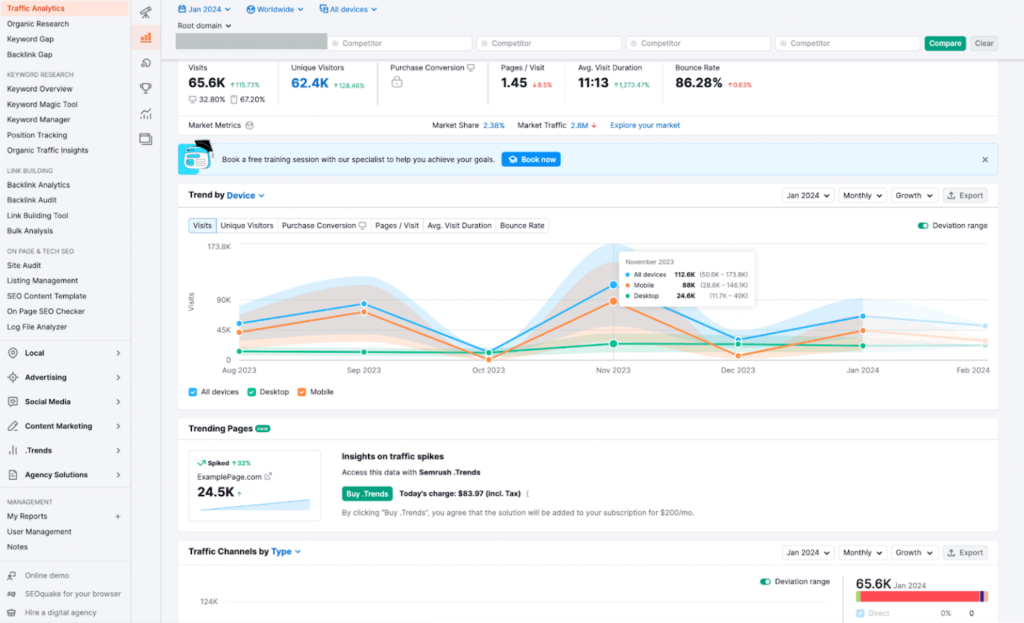The ben stace semantic seo writing tool arrives at a critical moment when achieving higher rankings on Google is no longer just about stuffing keywords or writing long paragraphs. I’ve watched Google’s algorithms evolve drastically with the introduction of Hummingbird, BERT, and MUM, making traditional keyword-based SEO increasingly ineffective.
So what makes this semantic SEO tool different? Unlike conventional approaches, it focuses on enhancing topic depth and authority while avoiding keyword stuffing penalties that can harm your rankings. Real results speak volumes: a home services business in Austin, TX increased organic traffic by 123% in just 3 months by targeting semantic variants. Similarly, a Los Angeles law firm reduced their bounce rate by 47% thanks to semantically optimized service pages with clear user intent alignment.
If you’re wondering whether semantic content writing is worth investing in, these case studies provide compelling evidence. We’re going to examine exactly what this tool offers, how it works, and whether it deserves a place in your SEO arsenal.
What Is the Ben Stace Semantic SEO Writing Tool?
The ben stace semantic seo writing tool represents a significant step forward in content optimization technology. As an AI-powered platform, it helps content creators develop material that’s semantically rich and contextually relevant rather than merely keyword-focused.
Core Purpose and Capabilities
At its core, this tool leverages natural language processing (NLP) and semantic analysis to generate content that satisfies both search engines and human readers. I’ve found it particularly effective for building topical authority through its advanced capabilities. These include topic mapping for related subtopics, intelligent keyword clustering to ensure content relevance, and competitive analysis of top-performing pages. Additionally, the tool provides real-time feedback on content structure, keyword usage, readability, and semantic density.
Furthermore, the platform identifies semantic gaps in content, suggests structured topic clusters, and enhances entity optimization across your entire content strategy. Through these capabilities, it helps establish what Google increasingly values – meaningful relationships between topics rather than isolated keyword instances.
Who Should Use This Semantic SEO Tool?
The tool caters to various professionals seeking improved search visibility. Bloggers striving for more organic traffic will appreciate its ability to boost topical relevance. Small businesses wanting to improve local and global rankings can leverage its semantic precision. Content creators and SEO professionals benefit from its ability to align writing with search intent.
Marketers looking to improve ROI on digital campaigns find value in its structured approach to content development. Consequently, agencies managing multiple clients can scale their content production while maintaining semantic integrity.
How It Differs from Traditional SEO Tools
Unlike conventional SEO platforms that focus primarily on keyword density, the Ben Stace tool emphasizes semantic relationships, content depth, and topic hierarchy. Traditional tools often lead to superficial optimization, whereas this solution analyzes contextual relationships between topics and generates natural language suggestions.
Moreover, the tool creates a multi-dimensional content environment supporting topical depth through entity mapping with schema types. This approach aligns perfectly with Google’s advanced algorithms, focusing on meaning and relationships rather than mere keyword frequency. The result is content that performs better for both search engines and readers – addressing the fundamental goal of modern SEO.
How the Tool Works: Step-by-Step Breakdown
Using the ben stace semantic seo writing tool follows a systematic approach that extends beyond traditional keyword optimization. Let’s break down how this powerful semantic platform actually works in practice.
Keyword and Topic Research
Initially, the process begins with identifying core keywords that align with your business objectives. Instead of just picking random keywords, the tool helps identify the main topic and related entities surrounding it—people, places, concepts, or tools associated with your primary subject. For instance, when working with a topic like “email marketing,” the tool would suggest including terms such as autoresponders, open rates, segmentation, and even specific platforms like Mailchimp to demonstrate comprehensive understanding.
Competitor Semantic Analysis
Next, the tool conducts a thorough scan of the top 20 search results for your target keyword. During this analysis, it extracts relevant semantic terms and secondary keywords that competitors are using effectively. This competitive analysis also reveals what your competitors might be missing, helping you identify content gaps that present opportunities for ranking. The tool’s AI-powered platform uncovers underrepresented concepts within current content sets, providing strategic advantages.
Content Structuring and Optimization
Afterward, the tool assists in creating detailed outlines featuring semantically related subtopics. This ensures your content flows naturally while covering topics comprehensively, rather than simply stuffing keywords. The system builds what Ben Stace calls “topical maps”—visual plans that include pillar pages covering entire topics and supporting cluster content that breaks down subtopics in depth. All these pages are strategically interlinked, signaling to Google that your website has complete authority on the subject.
On-Page SEO and Final Checks
Finally, the process concludes with comprehensive on-page optimization. This includes integrating meta tags, header tags, and internal links. The tool also facilitates schema markup implementation—including FAQ Schema, Article Schema, and HowTo Schema—to help search engines better understand your content. This structured data approach improves chances of getting rich snippets and increases click-through rates. Regular content audits are also recommended to add new facts, remove outdated information, and improve overall structure.
Real-World Results: Ben Stace Semantic SEO Case Studies

Evidence of the ben stace semantic seo writing tool’s effectiveness appears in multiple client success stories. Indeed, these case studies demonstrate tangible improvements across diverse industries.
Local Business in Austin: 123% Traffic Growth
An HVAC services company in Austin implemented the tool’s semantic approach, specifically targeting semantic variants of “HVAC repair services” instead of relying on exact-match keywords. Through schema-enhanced FAQ blocks and semantically labeled internal links, the business achieved a remarkable 123% increase in organic traffic within just three months. This growth stemmed from comprehensive coverage of related topics like “air conditioner maintenance” and “heating system troubleshooting”.
Ecommerce Store in NY: Page-One Rankings
A New York-based ecommerce retailer secured coveted page-one rankings after implementing the tool’s suggestions for topic clusters. By restructuring their blog content using topic nodes tied to core product categories, their sessions grew by 78% within five months. Furthermore, the store experienced a 5x increase in featured snippet wins alongside a significant reduction in bounce rates.
Law Firm in LA: Bounce Rate Reduction
At a Los Angeles law firm, semantically optimized service pages with clear user intent alignment reduced bounce rate by 47%. The implementation of schema-driven strategies, notably FAQ schemas for questions like “What is a personal injury lawyer?” secured valuable featured snippets. These improvements directly translated into better user engagement metrics and higher conversion rates.
What Makes It Stand Out from Other Semantic SEO Tools?

Several semantic SEO tools compete for attention in today’s market—nevertheless, the ben stace semantic seo writing tool offers distinctive advantages that justify its growing popularity among professionals who prioritize content quality and search performance.
Real-Time Content Scoring
Unlike batch processing systems, this tool delivers immediate feedback as you write. The system evaluates sentence structure, keyword placement, and semantic relationships simultaneously, allowing writers to make adjustments before completion. This live scoring mechanism balances creativity with optimization, preventing both under-optimization and keyword stuffing.
Semantic Precision and NLP Integration
Whereas many platforms like Surfer or Frase primarily focus on keyword density, Ben Stace’s tool emphasizes deeper semantic relationships through advanced NLP. The system identifies not just keywords but conceptual connections between topics. Through this approach, it helps writers build meaningful topical clusters that strengthen overall authority.
WordPress and Google Docs Integration
Beyond standalone functionality, the tool integrates seamlessly with popular writing platforms including WordPress and Google Docs. This practical integration eliminates workflow disruptions, especially valuable for agencies managing multiple clients or content teams requiring collaborative editing capabilities.
Affordability and Scalability
Perhaps most compelling, the tool provides enterprise-level semantic analysis at a price point accessible to businesses of all sizes. This democratization of advanced semantic technology means startups can compete with larger competitors on semantic optimization without prohibitive costs.
Conclusion
After examining the ben stace semantic seo writing tool from multiple angles, my verdict is clear: this tool delivers genuine value for anyone serious about modern SEO success. Traditional keyword-focused approaches simply fall short as Google’s algorithms grow increasingly sophisticated with each update. This semantic tool, however, aligns perfectly with how search engines actually evaluate content in 2025.
What stands out most is the impressive real-world impact demonstrated across diverse industries. Companies using this tool have achieved remarkable results – from the Austin HVAC business seeing 123% traffic growth to the LA law firm cutting bounce rates almost in half. These outcomes speak louder than marketing promises.
The tool’s comprehensive approach sets it apart from competitors. Rather than merely counting keywords, it builds meaningful semantic relationships between topics, creating content that satisfies both search engines and human readers. Additionally, its real-time feedback system helps writers maintain the perfect balance between optimization and readability.
Perhaps most importantly, the tool democratizes advanced semantic SEO techniques. Small businesses and independent content creators can now access technology previously available only to large enterprises with substantial marketing budgets. This accessibility, combined with seamless WordPress and Google Docs integration, makes it practical for daily use.
The question posed in the title asks whether this tool is worth the money. Based on my analysis, the answer depends on your specific needs. For businesses struggling with Google rankings despite quality content, this tool offers a strategic advantage that likely justifies the investment. Similarly, content creators looking to break through competitive niches will find significant value here.
Though no tool can guarantee overnight SEO success, the ben stace semantic seo writing tool provides a systematic approach aligned with Google’s evolving priorities. Instead of chasing algorithm updates, users can focus on creating genuinely valuable content while the tool handles the technical aspects of semantic optimization. This balance of creativity and technical precision ultimately delivers what matters most – content that ranks well because it truly deserves to.
FAQs
Q1. What is the ben stace semantic seo writing tool?
The ben stace semantic seo writing tool is an AI-powered platform that helps content creators develop semantically rich and contextually relevant material. It uses natural language processing and semantic analysis to optimize content for both search engines and human readers.
Q2. How does the tool differ from traditional SEO tools?
Unlike conventional SEO tools that focus primarily on keyword density, the Ben Stace tool emphasizes semantic relationships, content depth, and topic hierarchy. It analyzes contextual relationships between topics and generates natural language suggestions, aligning with Google’s advanced algorithms.
Q3. What are some key features of the ben stace semantic seo writing tool?
Key features include real-time content scoring, semantic precision through NLP integration, WordPress and Google Docs integration, and affordability for businesses of all sizes. It also offers topic mapping, intelligent keyword clustering, and competitive analysis of top-performing pages.
Q4. Who can benefit from using this semantic SEO tool?
The tool caters to various professionals seeking improved search visibility, including bloggers, small businesses, content creators, SEO professionals, marketers, and agencies managing multiple clients. It’s particularly useful for those looking to improve organic traffic and establish topical authority.
Q5. Are there any real-world success stories from using this tool?
Yes, there are several case studies demonstrating the tool’s effectiveness. For example, an HVAC services company in Austin achieved a 123% increase in organic traffic within three months, while a Los Angeles law firm reduced its bounce rate by 47% using semantically optimized service pages.


